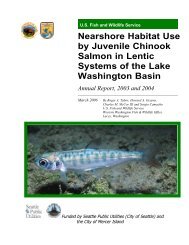Since the post-conservation era began in 1991, both the normalized demand withconservation and the actual demand with conservation have consistently been lower than thenormalized demand without conservation. By 2004, the demand (normalized) withconservation was 16% less than what it would have been without conservation.Figure 5-4Effect <strong>of</strong> Conservation on Demand - Total20,000,000Demand (gpd)18,000,00016,000,00014,000,00012,000,00010,000,0008,000,0006,000,0004,000,0002,000,0000Normalized DemandWithoutConservation (1)Normalized DemandWith Conservation(2)Actual Demand WithConservation1986198719881989199019911992199319941. For residential, uses baseline period water use factors. For commercial, uses 3-yr average <strong>of</strong> actual demand plusestimated conservation savings.2. For residential, uses 3-year average water use factors. For commercial, uses 3-yr average <strong>of</strong> actual demand.1995199619971998199920002001200220032004CONSERVATION PROGRAM FOR <strong>2006</strong>-2011<strong>Bellevue</strong>’s conservation program for the next six years, <strong>2006</strong>-2011, is designed to continuethe historical success, as well as to meet the stated objectives listed in Chapter 5.2. As notedabove, by 2004 <strong>Bellevue</strong> had achieved a 16% reduction in overall demand compared to whatdemand would have been without conservation.Selection <strong>of</strong> the conservation program components is also guided by the 2005 Cascade <strong>Water</strong>Alliance Conservation Potential Assessment (CPA). The CPA analyzed conservationopportunities and estimated water savings and costs associated with various conservationmeasures. The analysis was performed for each individual Cascade member, as well as forCascade collectively. For <strong>Bellevue</strong>’s portion <strong>of</strong> the CPA, the single family sector has thelargest savings potential (approximately 65% <strong>of</strong> <strong>Bellevue</strong>’s total savings), followed bymultifamily (approximately 25%) and then by commercial (approximately 10%). The CPAalso indicates that the outdoor portion <strong>of</strong> <strong>Bellevue</strong>’s single family sector has strong savingspotential, with approximately 25% <strong>of</strong> <strong>Bellevue</strong>’s total savings potential coming from thiscomponent. Therefore, <strong>Bellevue</strong>’s strong focus on the single family sector and landscapemanagement measures is consistent with the CPA analysis.Details <strong>of</strong> the <strong>2006</strong>-2011 conservation program are provided in Table 5-6. The table isstructured to show that the new program continues to meet or exceed DOH requirements, aswell as to allow for comparisons between new and historical programs. A summary5-19
Table 5-6Conservation Program for <strong>2006</strong>-2011Category Measure Summary Lead EntityN/AFull Time ConservationCoordinatorContinue staffing.<strong>Bellevue</strong>Continue 4 th grade Shared <strong>Water</strong>s curriculumand conservation kit, 6th grade Powerful ChoicesSchool Outreachfor the Environment program, Cedar River<strong>Bellevue</strong>, PSEwatershed tours, assembly programs, andteacher workshops.PublicEducationTechnicalAssistanceSystemMeasuresIncentives/OtherMeasuresSpeakers Bureau Continue providing speakers for groups. <strong>Bellevue</strong>Program PromotionContinue general program promotion throughbrochures, media releases, city newsletter,website, displays, demonstration projects, andmore.Theme Shows & FairsGeneral CustomerServiceCustomer Assistance:Residential AuditsCustomer Assistance:Commercial AuditsTechnical StudiesBill ShowingConsumption HistoryContinue providing display materials and staff tolocal and regional theme shows and events.Continue water use assessments and strategiesto reduce water use.Continue water usage audits and materials forhigh summer water users.Continue water usage audits for largecommercial customers.Evaluate participating in technical studies asappropriate.Continue providing consumption history on bills.5-20<strong>Bellevue</strong>, Cascade<strong>Bellevue</strong><strong>Bellevue</strong>CascadeCascadeCascade<strong>Bellevue</strong>Source MetersContinue metering, as well as meter testing andrepair.<strong>Bellevue</strong>, SPUService MetersContinue metering, as well as meter testing andrepair.<strong>Bellevue</strong>Leak Detection Continue leak control programs. <strong>Bellevue</strong>Single Family /Continue providing showerheads and faucetMultifamily Kitsaerators to multifamily customers.<strong>Bellevue</strong>, CascadeLandscape Mgmt: <strong>Water</strong> Continue landscaping-oriented conservationEfficient Landscape & requirements for commercial properties, street<strong>Bellevue</strong>Irrigation Requirements projects, and parks.Landscape Mgmt:<strong>Water</strong>wise Demo Garden& ClassesLandscape Mgmt: <strong>Water</strong>Efficient IrrigationProgramLandscape Mgmt:Summer Lawn Care(<strong>Water</strong>ing) CampaignConservation PricingUtility Financed Retr<strong>of</strong>its:Toilet RebatesUtility Financed Retr<strong>of</strong>its:ResidentialClotheswasher RebatesUtility Financed Retr<strong>of</strong>its:Commercial RebatesSeasonal DemandManagementRecycling and ReuseContinue landscaping-oriented conservationeducation, signage, and classes.Continue landscaping-oriented water usageaudits, technical assistance, and financialincentives for large commercial customers.Continue landscaping-oriented conservationthrough Northwest Natural Yard Days.Continue inverted block rate structure forresidential, seasonal rate structure forcommercial, and premium pricing for irrigationmeters.Continue toilet rebates for multi-family andcommercial customers.Continue clotheswasher rebates for residentialcustomers.Continue rebates up to 50% <strong>of</strong> installed cost formost equipment.Continue conservation pricing and landscapemanagement measures listed above.Continue promoting the use <strong>of</strong> reclaimed wateras appropriate.<strong>Bellevue</strong>CascadeMultiple Partners<strong>Bellevue</strong>CascadeCascadeCascade<strong>Bellevue</strong>, MultiplePartners<strong>Bellevue</strong>/Cascade
















